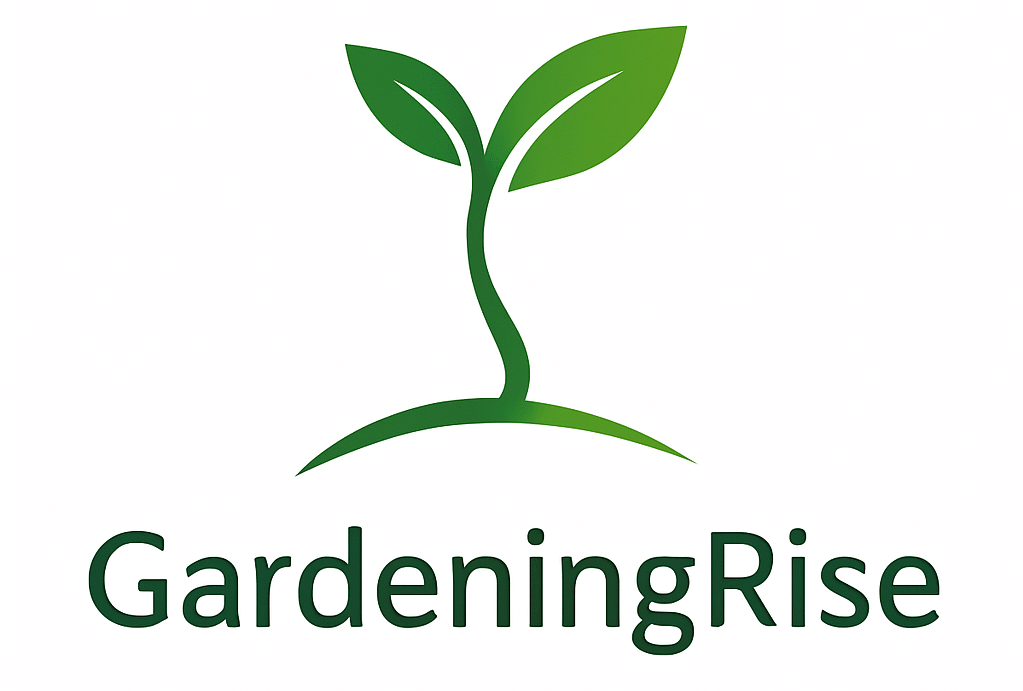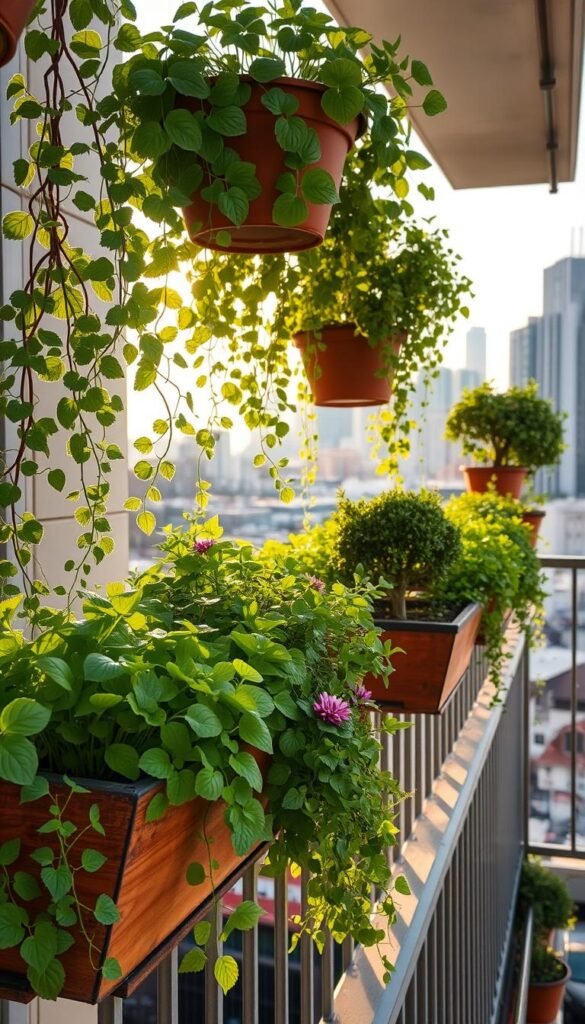Living in the city doesn’t mean you have to give up on greenery. With smart planning, even tight areas can become vibrant oases. Whether you’re working with a narrow ledge or a cozy corner, creative solutions like vertical arrangements or hanging planters let you grow herbs, flowers, and veggies without sacrificing style.
Choosing the right materials makes all the difference. Lightweight options like plastic or fabric grow bags save weight while providing durability. Pair these with self-watering systems to simplify maintenance—perfect for busy schedules or hard-to-reach spots.
Water management is key in small setups. Drip irrigation or moisture-retaining soil mixes help conserve resources. You’ll also discover how to mix trailing vines with compact shrubs for visual depth, turning bland walls into living art.
This guide walks through space-saving layouts, trending designs, and apartment-friendly care routines. Ready to unlock your outdoor potential? Let’s dig in!
Key Takeaways
- Vertical layouts maximize growing areas in tight spots
- Lightweight pots like fabric bags reduce structural strain
- Self-watering systems prevent over/underwatering
- Mix trailing and upright plants for visual impact
- Drought-tolerant species need less frequent care
Introduction to Your Urban Balcony Garden
City living offers unique opportunities to cultivate nature up high. Your balcony can burst with life when you approach it as a multi-layered canvas. Let’s explore how to turn overlooked corners into dynamic green zones.

Working With What You’ve Got
Small spaces thrive with adaptable planters. Try upcycled tin cans for herbs or stackable fabric pots for tomatoes. Even shoe organizers become vertical gardens when filled with succulents. The key? Match your choices to sunlight patterns and weight limits.
Building Your Green Foundation
Start by testing how much load your balcony can handle. Lightweight resin planters work well for railings, while ceramic pots stay grounded. Combine dwarf citrus trees with trailing perennials like creeping thyme for texture. This mix adds depth without clutter.
| Material | Weight | Best For | Durability |
|---|---|---|---|
| Fabric Pots | Light | Herbs/Flowers | 3-5 years |
| Plastic Planters | Medium | Shrubs | 5+ years |
| Repurposed Items | Variable | Small Plants | 1-3 years |
Success lies in balancing aesthetics and practicality. Choose plants that suit your microclimate—drought-tolerant varieties need less fuss. With clever layouts, you’ll create a retreat that feels larger than its square footage.
Maximizing Small Spaces on Your Balcony
Elevate your outdoor space by thinking beyond the floor. Vertical setups let you grow upward, while clever storage solutions keep essentials within reach. With the right approach, even a small balcony can host a thriving garden that feels spacious and inviting.

Vertical Gardening and Railing Planters
Turn blank walls into lush displays with hanging cable systems. Attach lightweight plastic planters to railings for herbs like basil or mint. Install a trellis for climbing plants—think snap peas or morning glories. These additions create layers of interest without eating into your standing area.
Railing baskets work wonders for flowers. Choose shallow designs to avoid blocking views. Pair them with foldable shelves that tuck away when not in use. This combo maximizes sunlight exposure while keeping walkways clear.
Smart Use of Tiered Planters and Hanging Baskets
Stackable tiers let you grow multiple plants in one footprint. Use fabric grow bags for strawberries or leafy greens—they’re easy to move as seasons change. Suspend macramé holders with trailing pothos or spider plants near seating areas for a cozy vibe.
Mix textures and colors for visual impact. Try combining silver-dollar eucalyptus with purple petunias in matching pots. This strategy draws the eye upward, making your balcony garden feel taller and more dynamic.
| Planter Type | Best Plants | Space Saved |
|---|---|---|
| Wall Pocket | Succulents | 100% floor area |
| Tiered Stand | Herbs | 70% floor area |
| Hanging Basket | Trailing Flowers | 90% floor area |
Understanding Your Balcony’s Limitations
Is your balcony ready to handle a lush garden? Start by sizing up its physical boundaries. Structural limits and environmental factors shape what you can grow—and how you grow it.

Assessing Weight and Structural Restrictions
Before adding hanging baskets or planters, check your balcony’s load capacity. Most structures hold 50-100 lbs per square foot. Wet soil and ceramic pots add up fast. Opt for lightweight resin or fabric containers to maximize space without overloading beams.
Rail-mounted systems work well for balcony gardens. They distribute weight evenly and keep floors clear. Avoid clustering heavy pots in one area—spread them out to prevent strain.
| Material | Weight When Filled | Best Uses |
|---|---|---|
| Plastic | 5-8 lbs | Herbs, annual flowers |
| Fabric | 3-6 lbs | Leafy greens, strawberries |
| Metal | 15-20 lbs | Small shrubs, dwarf trees |
Evaluating Sunlight, Wind, and Microclimates
Track sunlight patterns for 3 days. South-facing spots get 6+ hours of sun—ideal for tomatoes or roses. North-facing areas suit shade-loving ferns. Wind dries soil quickly, so mount hanging baskets in sheltered corners or use lattice screens as buffers.
Microclimates matter too. Concrete walls radiate heat, while glass railings intensify light. Match plants to these conditions. Lavender thrives in hot zones, while mint prefers cooler nooks.
With smart adjustments, you’ll grow balcony setups that look great and thrive year-round. Start small, observe changes, and adapt as needed!
Container Gardening Ideas for Urban Balconies
Your balcony’s potential blooms when containers and plants work in harmony. Let’s explore how material choices and creative combinations elevate both style and plant health.

Material Matters: Balancing Form and Function
Lightweight plastic pots shine for herbs and annuals—they’re easy to move and won’t strain railings. Ceramic planters add elegance for small shrubs but need sturdy surfaces. Fabric grow bags offer breathability, helping roots stay cool during summer heatwaves.
Consider durability too. Resin stands up to harsh weather, while recycled materials suit eco-conscious growers. Match container size to your plants’ growth habits—deep pots for carrots, wide bowls for succulents.
Mix, Layer, Thrive: Designing Dynamic Displays
Combine spiky dracaena with flowing sweet potato vines for texture contrast. Add pops of color using petunias or marigolds between foliage plants like coleus. This layering technique helps space create depth, making cramped areas feel lush.
| Plant Type | Container Pairing | Visual Effect |
|---|---|---|
| Trailing Ivy | Hanging Basket | Softens edges |
| Dwarf Citrus | Glazed Ceramic | Adds structure |
| Leafy Greens | Fabric Grow Bag | Modern farmhouse vibe |
Rotate seasonal stars like pansies or ornamental kale to keep things fresh. Most best plants for pots—like lavender or rosemary—thrive in well-drained soil. Remember: odd-numbered groupings often look more natural than even pairs.
Don’t fear experimentation! Try stacking mismatched pots or painting terra-cotta with weatherproof hues. Your plants grow best when their home suits their needs—and your personal flair.
Effective Watering Strategies for Your Container Garden
Keeping your plants hydrated in a high-rise setting requires smart solutions. Wind and sun exposure can dry soil quickly, but modern tools and techniques simplify the process. Let’s explore how to maintain ideal moisture levels without daily effort.

Choosing Self-Watering Pots and Irrigation Systems
Self-watering containers are game-changers for busy gardeners. Their built-in reservoirs supply roots with consistent moisture for up to two weeks. Pair them with ceramic pots for decorative flair—their porous walls help regulate soil temperature naturally.
Lightweight expandable hoses make watering easier on balcony terraces. Attach drip lines to slatted walls or railings for targeted hydration. This setup works wonders with grow bags, which dry faster than traditional planters.
| System | Best For | Water Savings |
|---|---|---|
| Self-Watering Pots | Small shrubs | 40-50% |
| Drip Irrigation | Container gardens | 60-70% |
| Wicking Beds | Herbs & veggies | 30-40% |
Reduce watering needs by selecting drought-tolerant plants like lavender or sedum. In windy spots, cluster ceramic pots near slatted walls to create windbreaks. Trays under grow bags catch excess water, letting plants drink later.
For scorching days, water early to minimize evaporation. Mulch helps retain moisture in container gardens. With these strategies, your balcony terrace stays lush even during summer heatwaves!
Incorporating Native and Ornamental Plants
Transform your elevated oasis into a wildlife sanctuary while boosting visual interest. Native species bring unmatched resilience and ecological benefits to compact spaces. As Heather McCargo of Wild Seed Project notes: “Local plants evolved with regional pollinators—they’re the ultimate team players in small-scale ecosystems.”
Growing Native Shrubs, Perennials, and Herbs
Start with compact varieties like purple coneflower or dwarf serviceberry shrubs. These thrive in apartment garden conditions with minimal watering once established. Pair them with aromatic herbs like mountain mint—a pollinator magnet that repels pests naturally.
Consider these low-maintenance stars:
- Wild columbine: Hummingbird-friendly flowers for shady corners
- Blue-stemmed goldenrod: Drought-tolerant vertical accent
- Bearberry: Evergreen groundcover for railing boxes
Mixing Foliage, Flowers, and Small Trees
Layer textures using native ninebark shrubs with burgundy leaves beneath ornamental cherry trees. Add seasonal pops with container-grown blazing star flowers. This approach ensures year-round color while providing shelter for urban birds.
| Plant Type | Container Size | Wildlife Supported |
|---|---|---|
| Spicebush | 15-gallon | Swallowtail butterflies |
| Joe-Pye Weed | 10-gallon | Bees & beneficial insects |
| Winterberry | 20-gallon | Winter songbirds |
For practical beauty, tuck native strawberry plants between ornamental pansies. Their trailing habit softens planter edges while yielding sweet treats. Remember: native doesn’t mean boring—vibrant cardinal flowers and aromatic sassafras bring drama to any garden setup.
Designing a Stylish and Functional Balcony Garden
Your balcony can become a chic retreat without compromising greenery. Blend form and function by treating every inch as a design opportunity. Start with vertical surfaces—they’re prime real estate for elevating both aesthetics and plant health.
Using Hooks, Trellises, and Slatted Walls for Vertical Appeal
Install slatted wall panels to mount lightweight pots or trailing vines. These structures add texture while letting air circulate freely. Use S-hooks to hang woven baskets filled with ferns or begonias—perfect for softening harsh lines.
Trellises aren’t just for climbers. Paint them bold colors to contrast with leafy greens. Train jasmine or clematis upward for natural shade over seating areas. This approach turns bland walls into living art.
| Vertical Element | Best Plants | Style Bonus |
|---|---|---|
| Iron Trellis | Passionflower | Industrial chic |
| Wooden Grid | Pothos | Rustic warmth |
| Wire Hooks | Herb Baskets | Farmhouse charm |
Combining Aesthetic Elements with Practical Solutions
Choose soil mixes tailored to your plants—cacti need gritty blends, while ferns thrive in moisture-retentive compost. Layer shade-loving caladiums under taller potted grasses for depth. This creates microclimates that boost growth.
Arrange containers in odd-numbered clusters near seating nooks. Place water-resistant wicker baskets beside sleek metal planters for contrast. Just ensure each pot has drainage holes to prevent root rot.
- Swap plain plastic pots for patterned fabric sleeves
- Use tiered stands to display herbs at varying heights
- Add solar string lights between baskets for evening ambiance
Balance beauty with practicality: leave 18-inch pathways for easy watering. With smart ideas like these, your balcony becomes an extension of your indoor living space—lush, welcoming, and uniquely yours.
Conclusion
Even the smallest outdoor area can flourish with thoughtful design. By embracing vertical layouts and strategic plant choices, you can craft a lush retreat that thrives against urban challenges. Remember: lightweight pots, self-watering systems, and wind-resistant species are your allies in creating a low-maintenance yet vibrant space.
Protection matters as much as aesthetics. Use trellises along walls or cluster tall plants to block harsh gusts. These living walls not only shield delicate greens but also add texture and depth to your setup. Pair them with moisture-retaining soil to combat drying winds naturally.
Ready to transform your space? Start with one sunlit corner and expand using the tips above. For more ways to optimize tight areas, explore innovative approaches tailored to high-rise living. Your green sanctuary—fresh, functional, and uniquely yours—is just a few planters away.






